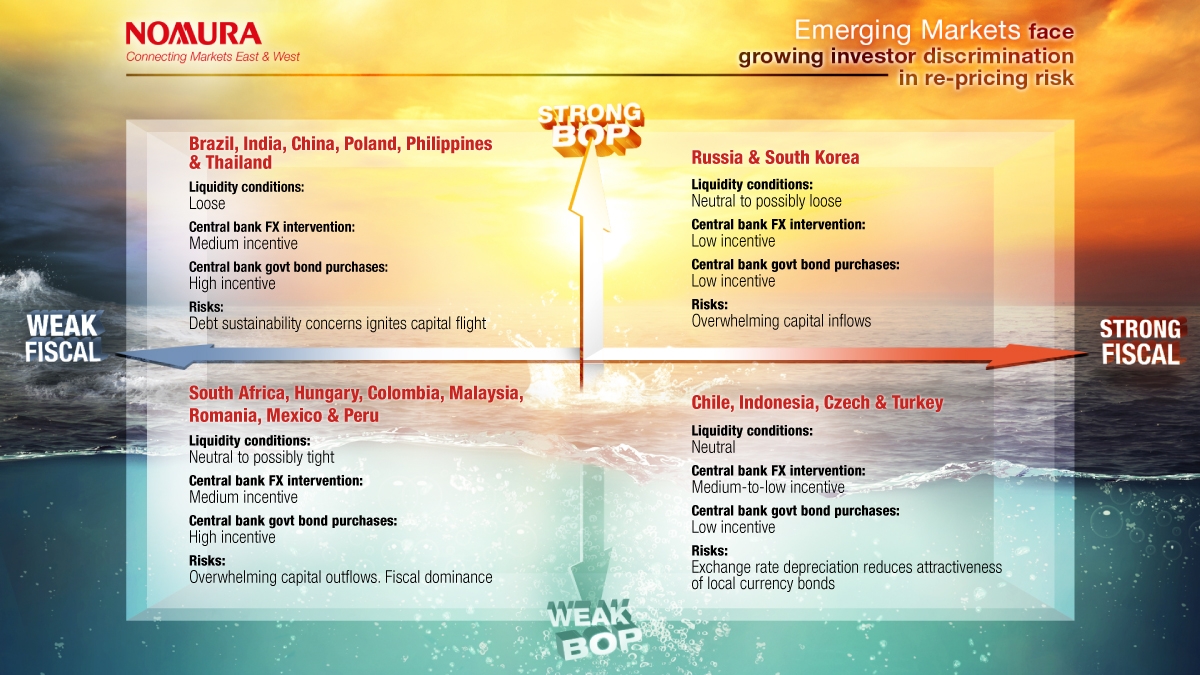
Emerging Markets’ Quantitative Easing Amid Rising Investor Discrimination
- We analyze the rapid growth in 20 EM central bank balance sheets and show how 10 are now larger than that of the US Fed (relative to GDP).
- EM central banks have subtlety followed their DM counterparts into the realm of QE, which is set to become a permanent part of the EM policy toolkit.
- We sort our 20 EMs into a 2x2 matrix to consider how capital flows, central bank interventions and liquidity could play out amid rising investor discrimination.
The pandemic-driven portfolio capital outflows from emerging markets (EM) in March were the largest ever recorded, but central banks staved off financial crises through innovative policy responses; for, in addition to allowing more exchange rate flexibility and drawing on FX reserves, no fewer than 18 EM central banks started bond purchase programs.
Aided also by the US Fed’s FX swap lines, EM’s decisive and unorthodox policy responses successfully short circuited the March market selloff. Rapid EM central bank balance sheet expansion has also flooded financial systems with liquidity.
This positive experience is unlikely to be a one-off. As conventional policy space is now limited, EM central banks will likely consider QE as a more permanent part of their policy toolkits, at a time when governments are becoming more reliant on them to help ease the financing pressure from ballooning fiscal deficits.
What happens next? The reality is that Covid-19 has left many EM economies are in terrible shape. Looking into next year, we expect foreign investors to turn more discriminatory in EM, demanding higher risk premiums from EMs that are deemed to face dangerously high debt levels and/or balance of payments (BOP) vulnerability.
In an environment of intensified foreign investor discrimination, we consider how capital flows, central bank interventions (in FX and bond markets) and liquidity conditions could play out by sorting our 20 EMs into a matrix of four quadrants, depending on whether they have relatively strong or weak BOP, and strong or weak fiscal positions.
There is significant differentiation among the 20 EMs, as highlighted by their positions in the four quadrants:
1. Strong BOP, weak fiscal (Brazil, India, China, Poland, Philippines and Thailand). Here, there are fairly strong incentives for central banks to intervene in both FX and bond markets. We would expect liquidity to be loose, local currencies to be stable to stronger against USD, and government bond yields to be stable to higher.
2. Strong BOP, strong fiscal (Russia and South Korea). Financial system liquidity conditions should be neutral to loose, as central bank intervention in either the FX or bond market would add to liquidity, but there is fairly low incentive for such actions. The risk is that these countries attract overwhelming capital inflows that could result in exchange rate appreciation overshoot and lower bond yields.
3. Weak BOP, weak fiscal (South Africa, Hungary, Colombia, Malaysia, Romania, Mexico and Peru). Liquidity conditions should be neutral to possibly tight, as there is some incentive to intervene in both FX and bond markets. If the central bank moves to the sideline, the risk is that a bond market selloff, capital flight, currency depreciation and inflation feed off of each other. Alternatively, excessive central bank bond purchases risk fiscal dominance and a loss of central bank autonomy over monetary policy.
4. Weak BOP, strong fiscal (Chile, Indonesia, Czech and Turkey). Liquidity conditions should be neutral. The combination of a weak BOP and a strong fiscal position suggests medium-to-low incentive for the central bank to limit currency depreciation, and a low incentive to purchase government bonds. The risk is the weak BOP dominates. Currency depreciation (particularly if there are limited FX reserves available to intervene) could fuel higher inflation, driving real bond yields even lower and making them even less attractive to foreign investors.
EM central banks and governments have thus far navigated the pandemic relatively well, avoiding full-blown financial crises. But, in those countries with deep recessions and weak economic fundamentals, the next phase could be the most challenging, as they have less policy space. This crisis has widened the disparities between strong and weak performing EM economies, a divide that we think investors will increasingly focus on, as they weigh the risk against returns in an environment with a much narrower interest rate differential between EM and DM, and every country simultaneously increasing debt issuance.
To gain more insight into factors affecting EM central banks, please read our full report here.
Contributor

Rob Subbaraman
Head of Global Macro Research

Rebecca Wang
Macroeconomic Research Analyst, Asia ex-Japan
Disclaimer
This content has been prepared by Nomura solely for information purposes, and is not an offer to buy or sell or provide (as the case may be) or a solicitation of an offer to buy or sell or enter into any agreement with respect to any security, product, service (including but not limited to investment advisory services) or investment. The opinions expressed in the content do not constitute investment advice and independent advice should be sought where appropriate.The content contains general information only and does not take into account the individual objectives, financial situation or needs of a person. All information, opinions and estimates expressed in the content are current as of the date of publication, are subject to change without notice, and may become outdated over time. To the extent that any materials or investment services on or referred to in the content are construed to be regulated activities under the local laws of any jurisdiction and are made available to persons resident in such jurisdiction, they shall only be made available through appropriately licenced Nomura entities in that jurisdiction or otherwise through Nomura entities that are exempt from applicable licensing and regulatory requirements in that jurisdiction. For more information please go to https://www.nomuraholdings.com/policy/terms.html.


